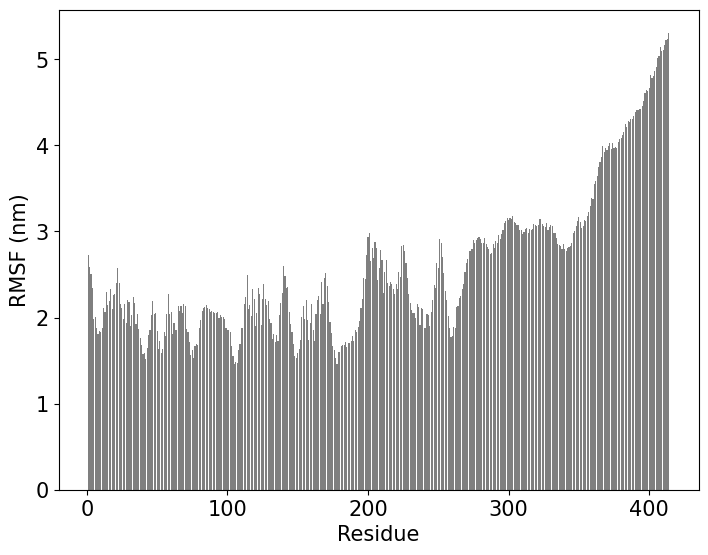Analysis
Copy relevant scripts in the analysis folder
!cp ../scripts_prep/* .
!zip files.zip script.sh pulchra.sh pulchra.py backmap.py simulate*.py dcd2xtc.py plumed_analysis.dat reconstruct.dat resample.py fes2.py sequence.dat plumed.dat struct*pdb input_af.pdb r1_excl.pkl forcefield.xml residues.csv *npy *mean*csv pdb_af.pdb keepH.sh
!mkdir analysis
!cp files.zip analysis/
os.chdir(dir+"/analysis")
!unzip files.zip
Run script.sh which:
- Convert dcds to xtc (dcd2xtc.py)
- Concatenate xtcs to a single xtc
gmx trjcat -f nosolv_*.xtc -cat -o cat_trjcat.xtc -settime - Calculate the Torrie-Valeau weights (Fullbias.dat) and the CVs (COLVAR)
plumed driver --plumed plumed_analysis.dat --mf_xtc cat_trjcat.xtcwhich are afterwards used to calculate Free Energy Surfaces. - Generate a structural ensemble by sampling the concatenated trajectory by weights.
python resample.py - Backmap coarse grained structural ensemble by using PULCHRA
python backmap.py $nrep sh pulchra.sh sh keepH.sh
!pwd
!chmod 755 script.sh
!./script.sh {NR}
#The final atomistic structural ensemble.
!ls segment_5_input_af_rebuilt.xtc
Plot the free energy surface per CV of interest. Note that the order of CVs in: for i in $(echo CV1 CV2 CV3 etc);do .. needs to follow the order these CVs appear as columns in the COLVAR file.
#Time depentent FES
#For other proteins the entries CV1,CV2,CV3 etc need to follow the COLVAR columns like:
#for i in $(echo CV1 CV2 CV3 etc);do
!num=1
## For TDP-43 WtoA
!for i in $(echo Rg Rg1 Rg2 Rg3 Rg4 torsion1 torsion2 RMSD1 RMSD2 RMSD3);do python fes2.py --CV_col $num --CV_name $i ; num=$((num+1)) ; echo $num; done





a)Rg, b)Rg1, c) Rg2,d) Rg3, e) Rg4
Calculation of the Root Mean Square Fluctuations (RMSF) per residue.
!echo "0" |gmx rmsf -f segment_5_input_af_rebuilt.xtc -s segment_5_input_af_0_sys.pdb -res -o rmsf.xvg
import numpy as np
from matplotlib import pyplot as plt
x=np.loadtxt("rmsf.xvg",comments=['#', '$', '@'])[:, 0]
y=np.loadtxt("rmsf.xvg",comments=['#', '$', '@'])[:, 1]
#print(x)
#print(y)
fig = plt.figure()
ax = fig.add_axes([0,0,1,1])
ax.bar(x,y,color="black",alpha=0.5)
plt.yticks(fontsize=15)
plt.xticks(fontsize=15)
plt.xlabel('Residue',fontsize=15)
plt.ylabel('RMSF (nm)',fontsize=15)
ax.tick_params(axis='both', labelsize=15)
ax.legend=None
plt.savefig('rmsf.pdf',bbox_inches='tight')

Finally,to showcase the advantage of AF-MI, we show pair-distance distribution function (PDDF) from SAXS data, based on a single AF PDB structure and AF-MI structural ensemble Ref.

Download files
print(home)
!pwd
!rm segment_5_input_af_*.rebuilt.xtc segment_5_input_af_*.rebuilt.pdb
!zip -r {home}/archive.zip {home}/AlphaFold-IDP/prep_run
#!zip -r {home}/archive.zip *png ../plumed.dat plumed_analysis.dat reconstruct.dat segment_5_input_af_rebuilt.xtc segment_5_input_af_0_sys.pdb rmsf.pdf ../pae_m.png FES*png FULLBIAS COLVAR ../HILLS* ../COLVAR*
from google.colab import files
files.download(home+"/archive.zip")
